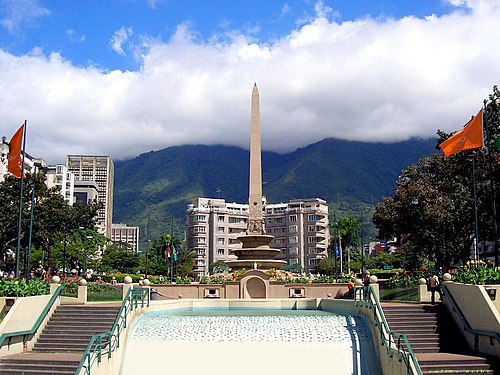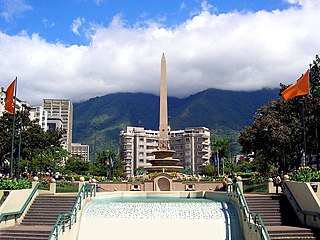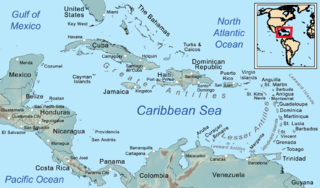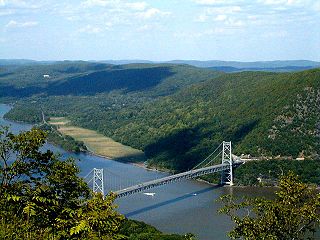
The Capital District is Venezuela's federal district. It has an area of 433 km2 and there is only one administrative division (municipio), Libertador, which contains about half of Caracas, the Venezuelan capital city, which is also the seat of the three branches of the federal government of Venezuela.

Chacao is one of the five political and administrative subdivisions of the city of Caracas, Venezuela. The other four are Baruta, El Hatillo, Libertador and Sucre. This legal entity is known as the Caracas Metropolitan District. Chacao is also one of the 21 municipalities that make up the State of Miranda, Venezuela.

Municipalities of Venezuela are subdivisions of the States of Venezuela. There are 335 municipalities dividing the 23 states and Capital District.

El Hatillo Municipality is an administrative division of the State of Miranda, Venezuela; along with Baruta, Chacao, Libertador and Sucre, it is one of the five municipalities of Caracas, the capital of Venezuela. It is located in the southeastern area of Caracas, and in the northwestern part of the State of Miranda.

The Libertador Bolivarian Municipality is the only administrative division of the Capital District and along with the municipalities of Baruta, Chacao, El Hatillo and Sucre forms the Metropolitan District of Caracas. It is landlocked by Vargas State and also borders Miranda State on the east and south. The municipality is one of a number in Venezuela named "Libertador Municipality", in honour of Venezuelan independence hero Simón Bolívar.

Las Mercedes is the largest district for shopping and leisure in Latin America. It is located at the Baruta Municipality, Miranda (state), Caracas.
The Ministry of Aquatic and Air Transport is a ministry of the Government of Venezuela. Its head office is on the 12th floor of the Torre Pequiven in Chacao Municipality, Caracas.

El Rosal is a neighbourhood of Caracas, Venezuela, in the Chacao municipality. It is located at East Caracas, near the geographic center of Caracas and is one of its financial centres.
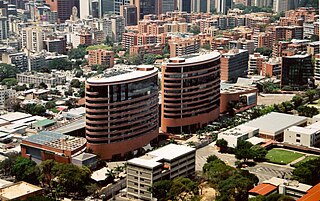
La Castellana is a district in Caracas, Venezuela, located in the northeast part of the city, La Castellana is bordered on the south by Chacao, on the east by Altamira (Caracas) neighbourhood, on the west by Caracas Country Club and Campo Alegre neighbourhood and on the north by El Ávila National Park.

Campo Alegre is a residential neighborhood located in the Chacao municipality of Caracas, Venezuela. This district holds the hotel Embassy Suites by Hilton , and the most exclusive party room of the city, the "Quinta Esmeralda", meeting point of the Venezuelan upper-class families.
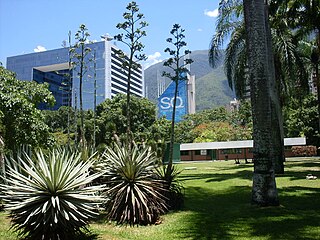
Los Palos Grandes is a residential, tourist and financial district located in the Chacao Municipality in east Caracas, served by the Caracas Metro through the Miranda station of line 1.

The 2014 Venezuelan protests began in February 2014 when hundreds of thousands of Venezuelans protested due to high levels of criminal violence, inflation, and chronic scarcity of basic goods because of policies created the Venezuelan government. The protests have lasted for several months and events are listed below according to the month they had happened.

The 2015 Venezuelan protests began in the first days of January primarily due to shortages in Venezuela, with the first massive demonstration occurring on 23 January. The series of protests originally began in February 2014 when hundreds of thousands of Venezuelans protested due to high levels of criminal violence, inflation, and chronic scarcity of basic goods because of policies created the Venezuelan government. As of January 2015, over 50 people had been arrested for protesting. The protests are listed below according to the month they had happened.

East Caracas generally refers to the eastern portions of Caracas, and may refer specifically to the municipalities from the Metropolitan District of Caracas located in Miranda State: Chacao, Baruta, Sucre, and El Hatillo. It concentrates the 34.8% population of the Metropolitan District of Caracas, and the 21.7% population of the Greater Caracas Area. A very small portion of East Caracas is located in El Recreo Parish of Libertador Municipality, however. That area is considered the East-Center portion of Caracas. Caracas Country Club, the richest neighborhood of the city, is located between El Recreo and Chacao districts.
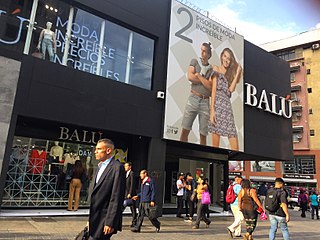
The Sabana Grande district is divided into several middle class neighborhoods located in the Parroquia El Recreo of the Libertador Municipality, in the geographical center of the Metropolitan District of Caracas and owes its name to the old town of Sabana Grande. The Twin Towers of El Recreo Shopping Mall occupy the position number 5 and number 6 of the tallest skyscrapers in Caracas, the capital of Venezuela. The most important neighborhoods of the district are: Sabana Grande, Bello Monte, San Antonio de Sabana Grande, Las Delicias de Sabana Grande and Los Caobos. Sabana Grande is an important commercial, financial, residential and cultural area within the city in the Capital District, on the east side of the central Plaza Venezuela and Los Caobos. The commercial and financial district Sabana Grande is the main commercial corridor of the city and it is estimated that more than 500 thousand people visit it daily. Parroquia El Recreo, specifically Sabana Grande, is the most commercial area of the Libertador Municipality and produces more than half of its tax revenue. For several years, Parroquia El Recreo has wanted to be an independent municipality. Sabana Grande is a district with a very rich history and was the cradle of Venezuelan democracy, since the Puntofijo Pact was signed there. Before suffering a cerebral infarction in 2009, Argentine musician Gustavo Cerati had gone out to party at the Bohemian club Moulin Rouge, located on Francisco Solano López Avenue in Sabana Grande.

The Boulevard of Sabana Grande is an important leisure and shopping area located in eastern Caracas in the geographic center of the Metropolitan District of Caracas. It is a pedestrian-only, tree-shaded public space. In 2011, the boulevard of Sabana Grande went through a rehabilitation process, thanks to PDVSA La Estancia. A commercial and financial district, Sabana Grande is the commercial corridor, and a tourist district of Caracas and is visited by an estimated 500 thousand people or more daily. Since the construction of the boulevard, the Sabana Grande district has become the main meeting place of Caracas.. Today, Sabana Grande has stores such as Balú H&M, Apolo Shoes, Brands Shop (Estivaneli-Alcott) Planeta Sports (Levi's), Angely, AISHOP, Mango and others. Many important public works of art are displayed along the boulevard and it is considered an open air museum. The boulevard of Sabana Grande is home to the most important ornithological collection in Latin America, the William Phelps Ornithological Collection. It is the space preferred by the LGBT community and urban tribes. The boulevard of Sabana Grande replaced Abraham Lincoln Avenue. Until the beginning of the 20th century, it was called Calle Real because it was the town's main road. Sabana Grande was the residence of Jenie Soep Bamberger, one of the most important madams in 20th century Latin America. The first gay march in Venezuela took place in the Sabana Grande district at midnight on June 23, 1997. City Market Shopping Center, known as the technology center of Caracas, is also located here. In 2013, Revista Distorxión displayed a guitar autographed by Good Charlotte in the City Market Shopping Mall. The boulevard of Sabana Grande is also considered the main bohemian district of Caracas.

El Cafetal is a neighborhood located in the Baruta Municipality of Caracas, Venezuela.




